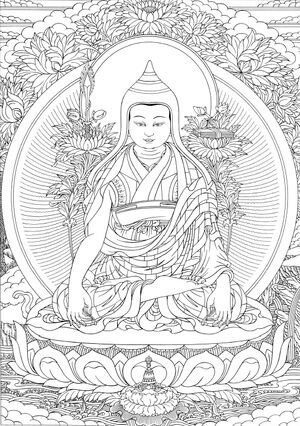Longchen and Buddha-Nature
Longchenpa, or Longchen Rabjampa Drime Õzer, is undoubtedly the most influential philosopher of the Nyingma school and the main promoter of the teachings of Nyingthig (སྙིང་ཐིག་), or Seminal Quintessence. He was a scholar, poet, and mystic of phenomenal caliber, and it was for his vast learning that he was given the honorary title of Longchenpa (ཀློང་ཆེན་པ་), or "Vast One," by Tai Situ Jangchub Gyaltsen, the Tibetan ruler of his time.
Longchenpa synthesized the Buddhist teachings in general and Dzogchen thought in particular for the Nyingma school and left behind a large literary legacy which includes the Seven Treasures (མཛོད་བདུན་), Trilogy of Self-Liberation (རང་གྲོལ་སྐོར་གསུམ་), Trilogy of Relaxation (ངལ་གསོ་སྐོར་གསུམ་), and Seminal Quintessence in Four Parts (སྙིང་ཐིག་ཡ་བཞི་). Although we do not have a commentary on the Ultimate Continuum by Longchenpa (see the June 2021, Week 3 post in this blog for more discussion on this), he has commented on the most critical verses, including Verses I.128, 154, and 155 of the Ultimate Continuum in his other writings. As a prolific writer on the theory and practice of Dzogchen, the topic of buddha-nature appears in most of his writings in the context of the ultimate nature of the mind which one needs to realize and the ground reality from which the phenomenal world and empirical experience arise.
Longchenpa blends the sūtra presentation of buddha-nature with the esoteric exposition of the spontaneous primordial ground in the tantras. He uses terms such as essence, element, spiritual gene, innate mind, pristine wisdom, vajra mind, primordial ground, the ultimate, ground gnosis, sphere of reality, Middle Way, nondual truth, thatness, Perfection of Wisdom, etc., to refer to the same luminous nature of mind which is buddha-nature. His exposition on buddha-nature occurs most saliently in three of his main writings. In his Relaxation in the Nature of Mind, Longchenpa deals with buddha-nature in the opening verse while paying homage to the ultimate truth, in chapter 9 while discussing the generation-stage- and completion-stage practices, and in chapter 10 on the topic of wisdom which comprehends the ground reality free from the two extremes. He presents buddha-nature as the ground maṇḍala, which forms the basis of temporary confusion, while at the same time being the uncontrived, unborn, unchanging nature of the mind to be realized on the path. Ordinary beings do not perceive this buddha-nature, but bodhisattvas on the stages see it partially and the buddhas see it fully.
In his Treasury of Tenet Systems, Longchenpa carries a more detailed exegesis of the buddha-nature in chapter 4 on the spiritual gene required for the practice of Mahāyāna path. He cites several sūtras and many critical verses from the Ultimate Continuum, on which he comments to make clear his interpretation of buddha-nature teachings. He considers buddhahood as being identical with buddha-nature latent in all sentient beings and argues that buddhahood is a result which is revealed rather than a fruit which is cultivated and produced. Thus, all qualities of the Buddha are primordially present in the nature of all sentient beings.
Similarly, in chapter 1 of his Treasury of Wishfulfilling Jewel, he expounds the theory of buddha-nature as the primordial ground from which both nirvāṇa and saṃsāra arise. In chapter 18 he discusses the abiding nature of reality, which is the ultimate truth, and presents the experiences of saṃsāra as temporary illusions arising from adventitious misconception.
Buddha-nature is understood to be the empty, luminous nature of things which abides as the ontic reality in all sentient beings and is free from all fabrications. Using the terms from the sūtras teaching buddha-nature and the Ultimate Continuum, he characterizes buddha-nature as the ultimate pure, eternal, blissful self. He considers the teachings on buddha-nature which form part of the third wheel as definitive teachings, which expound the same ground nature presented in both the sūtra and tantra literature. In summary, he writes in the Treasury of Wishfulfilling Jewel:
- འོད་གསལ་བདེ་གཤེགས་སྙིང་པོ་ལྷུན་གྲུབ་སྟེ། །སྟོང་གསལ་རིག་པ་དབྱེར་མེད་ཆོས་ཉིད་དོ།།
The luminous buddha-nature is indivisible reality
Which is spontaneous, empty, and clear awareness.
His presentation on buddha-nature theory and associated practices in his writings became the most authoritative references which determine the interpretation of buddha-nature theory and practice in the Nyingma tradition to this day.
Weekly quote
~

